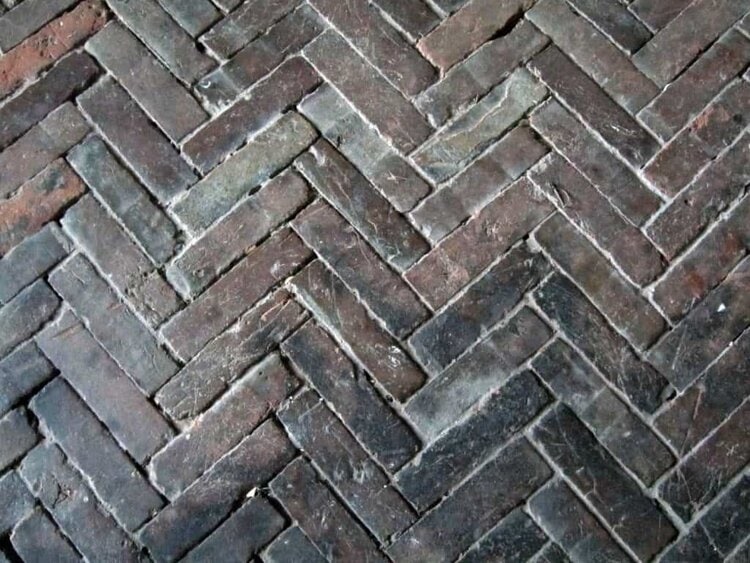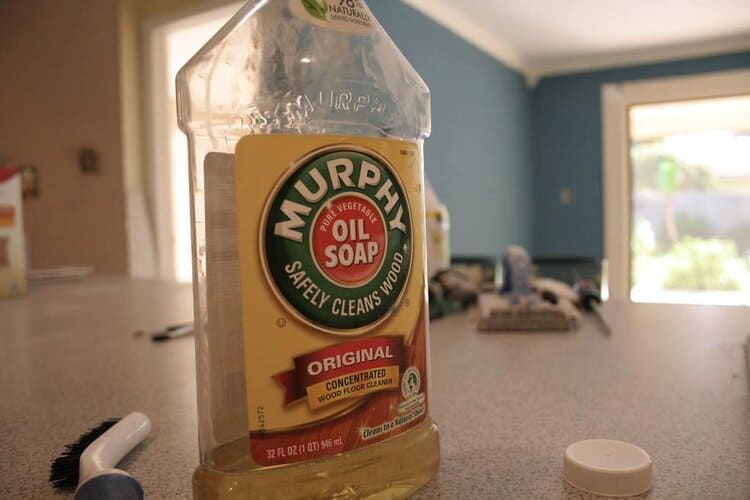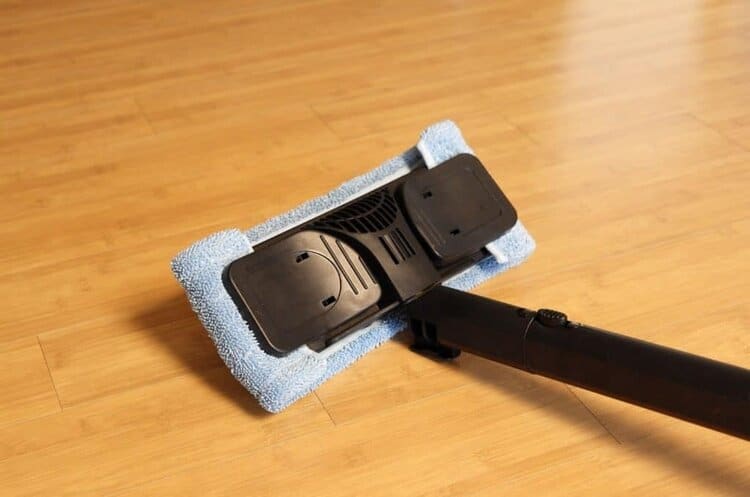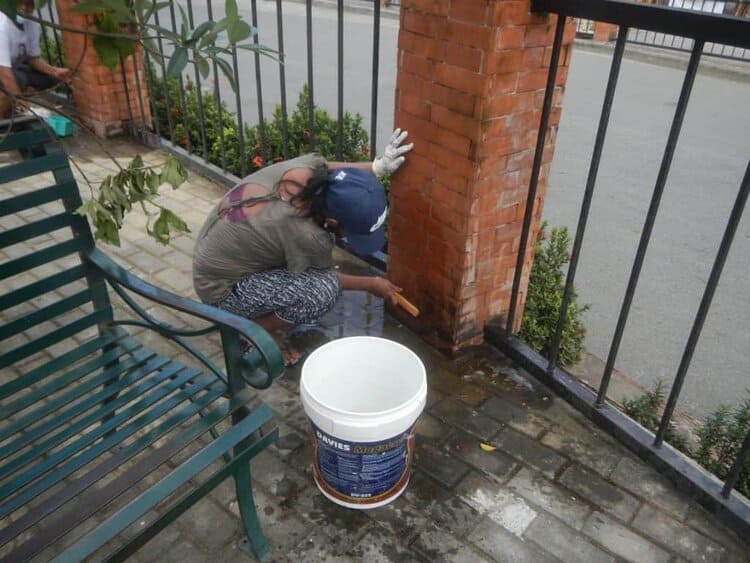Pour 8 ounces of vinegar and 1 liter of water into a bucket while mixing thoroughly. Next, dip your mop into the cleaning solution and wring any excess water off it. Then, mop your brick floor in a back and forth movement to eliminate all the grime and dust particles. Lastly, dry your surface with a microfiber towel.

Brick floors make your house look more elegant while being easy to clean. However, if you’re not proactive in maintaining it, the accumulated dirt will make them look unattractive.
Filth and grime eat away at the brick’s protective surface, causing it to be exposed to the elements.
As a result, your floor will be defenseless and start to decay piece by piece.
If you are having this experience now, this guide will help you with everything you need to alleviate the situation. We’ll teach you the steps in depth so you learn the specific actions you need to take to clean your bricks properly.
How to Vacuum or Sweep Brick Floors
It’s important to vacuum and sweep every day, no matter the season, to keep dirt and grime at bay.
Feel free to use a traditional sweeper. One of your goals is to focus on the mortar holding the bricks together to check for filth, usually ignored because it’s barely visible.
To make your life easier, you can use a vacuum meant for hard floors. These appliances come with soft brush extensions that eliminate dust and animal hair. It’s advised you stay away from rigid attachments like a beater bar. They are known to destroy brick or mortar surfaces, and repairs are expensive.
When dealing with unsealed brick, you will notice more grime accumulation than usual, and it gets worse in an area with a lot of foot traffic.
Grime also wreaks havoc on other parts of your home like hardwood floors, marble tiles, and carpets, causing irreparable damage. Avoid this scenario by sweeping and vacuuming regularly to keep dirt from spreading.
How to Mop Brick Floors
Once you sweep as much dirt out as you can, it’s time to mop your brick floors for a complete cleanse. The process below is easy to follow and won’t take much time.
What You’ll Need
- Medium Bucket
- Mop( we highly recommend using a spin mop)
- Microfiber Towels
- Water
- Nylon Brush with tough bristles
- Mild Alkaline Floor Cleaner (Murphy’s Oil Soap is recommended)
Instructions
Step 1: Pick A Cleaning Solution
Mild alkaline cleansers like Murphy’s Oil Soap are the best for brick floors. This cleaner is popular and used by many to clean hard floors safely without tainting them in the process.

You can also go the DIY route and try a home remedy cleaner. Take a look at a few of these below:
- Borax – Fill a bucket with 5 liters of water and mix 2 tablespoons of borax into the solution. Don’t use more than the recommended amount when applying it to a brick floor because borax is a potent alkaline.
- Baking Soda – Mix 2 tablespoons of baking soda into a bucket with 5 liters of tap water. Then stir for 1 minute or until the baking soda dissolves. Baking soda is safer for a beginner since it is slightly weaker than borax. You can also use it for stain removals and absorbing unpleasant smells.
- Vinegar – Add 4 ounces of vinegar into a bucket with 4 liters of water. Vinegar is highly acidic and an effective all-natural solution for cleaning everything in your home. You can use it to polish floors, remove odors, and kill surface bacteria.
Step 2: Mop Your Floor
Once you’ve chosen your alkaline floor cleaner or mixed up a batch of your own, you can begin mopping. Follow the instructions on the back of the commercial cleaner’s bottle if you bought one from a store.
While mopping your brick floors, make sure it’s wet enough. You must give it the necessary time in the bucket to absorb the cleaner liquid. But wring a bit of the mixture out while ensuring it has a sufficient amount.
We recommend a spin mop to make this step easier because it perfectly removes excess water.
Use a front and back motion when mopping your floor while applying minimal force with your arms. You need more muscle than you usually would on regular hard floors. That extra bit of pressure will guarantee you clean the gaps in brick floors that are difficult to clean.
We advise you don’t try using sponges or traditional cloth mops that tear easily on brick surfaces.
The best mops for this type of floor have microfiber strings. But if the stains or grime are more of a challenge to remove, take your nylon brush and start scrubbing from top to bottom.
Tip: The rule of thumb is if you can’t see the bottom of your bucket or the cleaning mixture turns black, you need to get rid of it and stir up a fresh batch. Using filthy water to clean your floors will make your floor dirtier.
Step 3: Dry Your Floor
We suggest you don’t skip this step because brick floors should never be left wet.
Use a delicate microfiber towel to absorb any remaining water on the surface. Then, spend extra time on grout lines because the cleaning mixture will stain your bricks if you leave excess moisture between the gaps.
When the floor is dry, you can rest knowing your bricks will shine and you won’t see any streaks.
Cleaning Brick Floors with A Steam Cleaner
Steam cleaners are convenient for numerous tasks in your house.
They effectively clean most surfaces but are used chiefly for restroom tiles and kitchen countertops. These appliances are underrated and give brick floors a deep cleanse that a simple mop could never do.
You will also be able to eliminate stains with less physical exertion.
The hot vapor from your steam cleaner opens up the pores of your bricks the way steam does with the ones on your face. This steam pushes out all the grime, dust, and water that helps get rid of foul odors.
Lastly, a thorough steam cleaning is needed if you haven’t sealed your floors but want to do so.

Where Does the Dust Come From?
Typical issue homeowners have when installing brick floors is what to do with all the dust on the surface after installation. The color of this dust is faded but still easy to spot. If it’s a windy day, it will spread to other areas and become a headache to handle.
These tiny particles come from muriatic acid that connects to grout used to keep bricks held together. Most people don’t know that it’s a form of hydrochloric acid. This eroding chemical helps keep brick surfaces spotless.
To eradicate this light-colored dust, use your steam cleaner or mop repeatedly with warm water.
The good news is that this acid is no longer common, and most contractors utilize a less traditional commercial cleaner that’s expensive but leaves very little dust behind. Whatever dust is left is more straightforward to clean.
Handling Grout
The grout lines are the weakest part of a brick floor. Like a sponge, it takes in any liquids, and this absorption causes issues with the color of the grout resulting in ugly stains.
The best way to avoid this situation is by sealing it. Nothing will get in or out of the bricks once you do. Repeat the sealing process once per year to keep it shielded.
If stains appear along the grout lines, remove them with a mild alkaline cleaner. DIYers can make a stain remover at home by mixing 4 ounces of baking soda and 16 ounces of water to create a paste.
Put the paste on the affected areas and scrub them with a nylon brush until they disappear. Then you can wipe your brick floor with a microfiber towel to ensure it’s dry.
Steam cleaners are another alternative you can try to wash grout lines. But the pressure coming from this appliance will often clear out the sealer in the process. You must take the grout out and apply a new line if this happens.
Cleaning Bricks Outdoors
Brick patio floors make your home stand out but require some upkeep. Depending on the climate, you will have to worry about protecting your floor from grime, dust, and other elements.

Acidic cleaners bought in the store are the best. All you have to do is follow the instructions on the label to start cleaning.
To make your life easier, clean with a pressure washer, and you can finish in half the time. The trick is to know what you are doing because if you don’t, the high pressure of the water can damage your brick floors.
Never put the washer too close to your floor and follow the maximum distance requirement in your appliances instruction manual.
Lastly, Use flat nozzles to avoid scratching the surface of your floors.
FAQs on Best Ways to Clean Brick Floors
Are brick floors hard to clean?
Brick floors are easy to clean if you keep them sealed correctly, but if you don’t, they will attract stains. Remember that even sealed brick floors need to be cleaned every 1 to 2 weeks.
What are the disadvantages of brick flooring?
Unlike other hard floors, brick floors are uncomfortable to lay on. Another drawback is how hard these floors are to clean when you break objects that shatter on them like glass.
Can Roomba clean brick floors?
Roombas cannot clean brick floors because these floors are not smooth to ride on. Trying to get past deep grout is impossible, and this appliance would get stuck often.